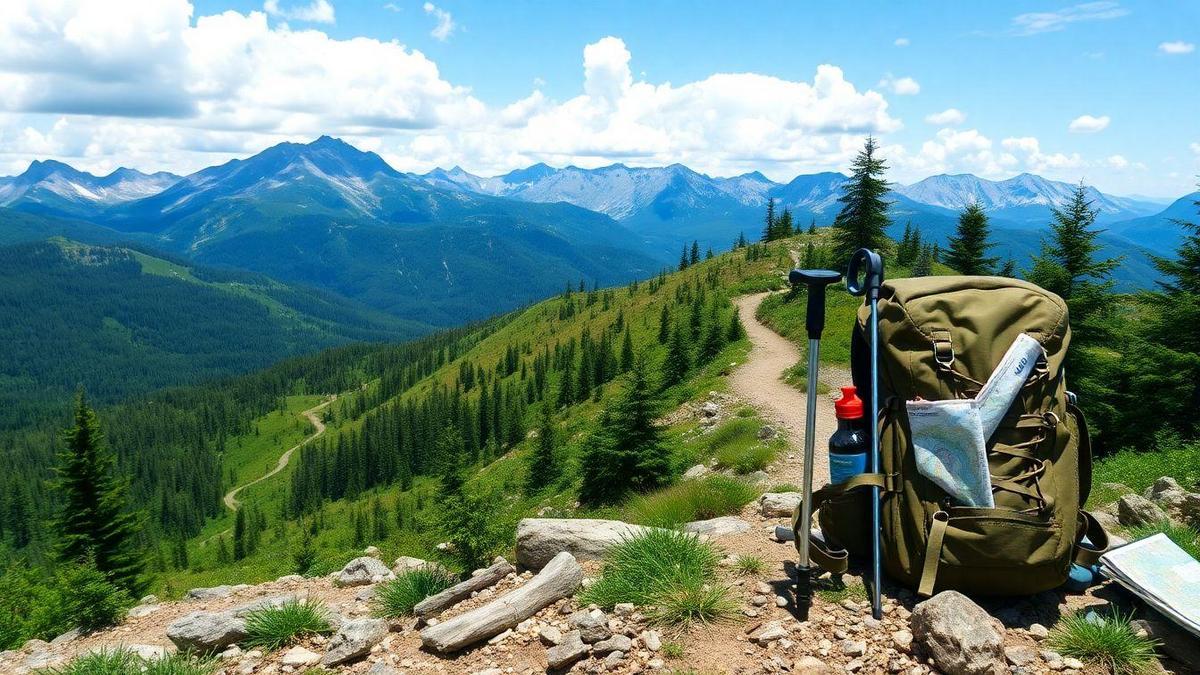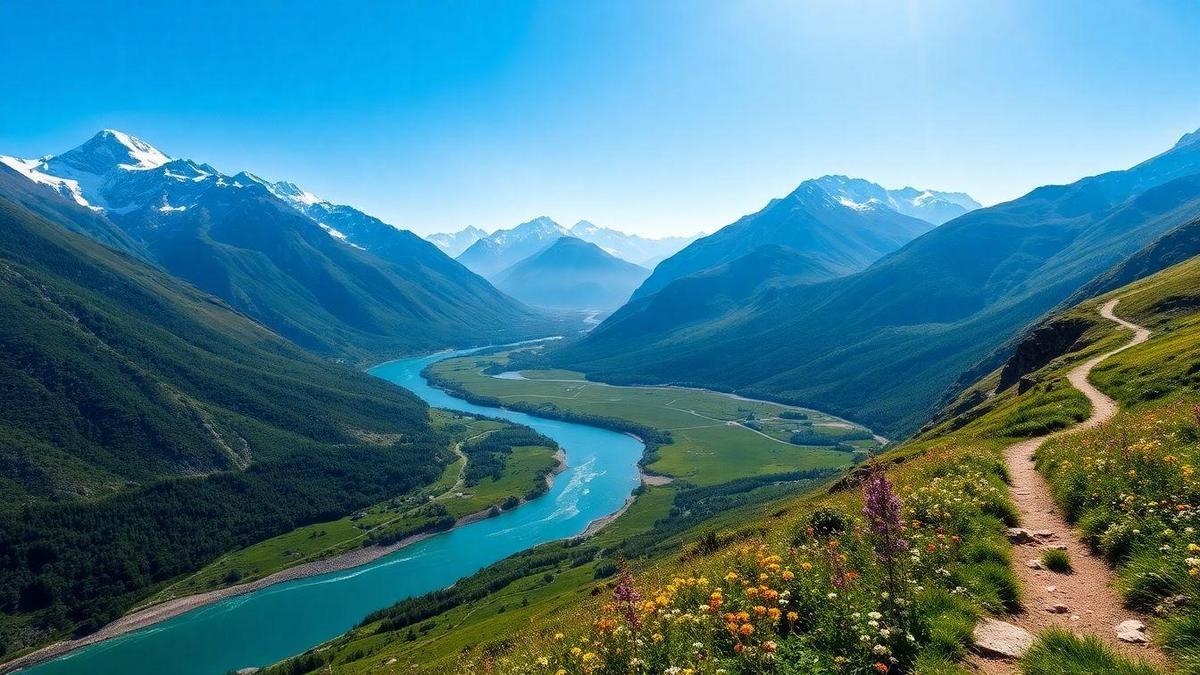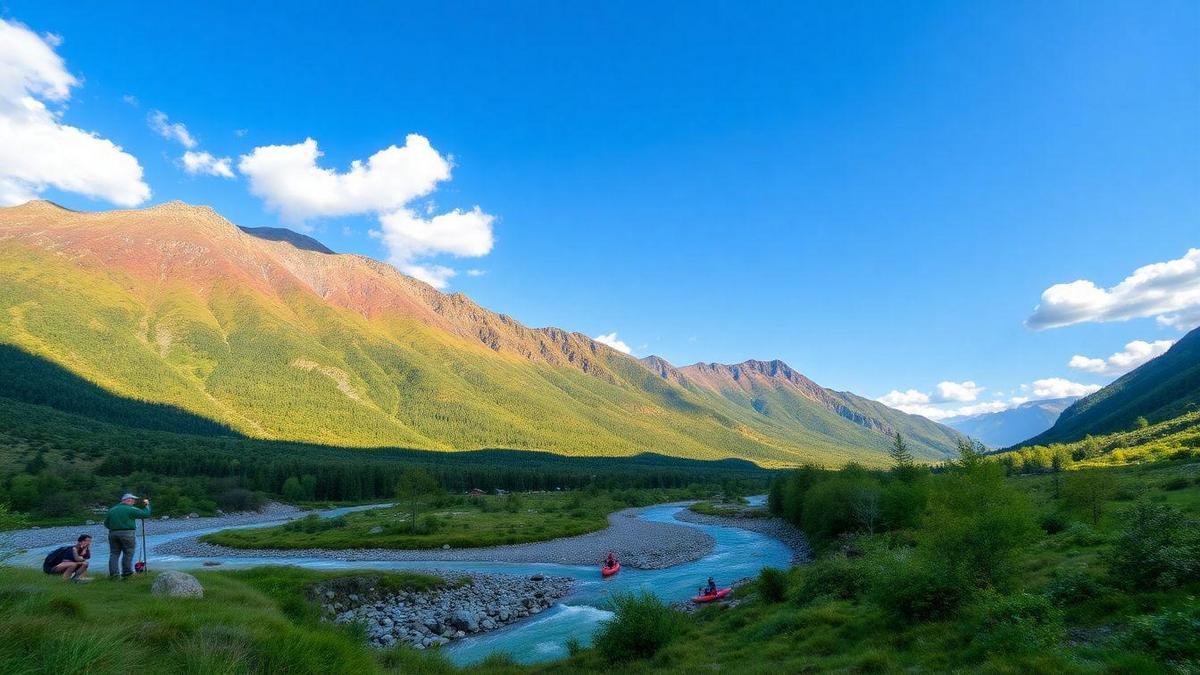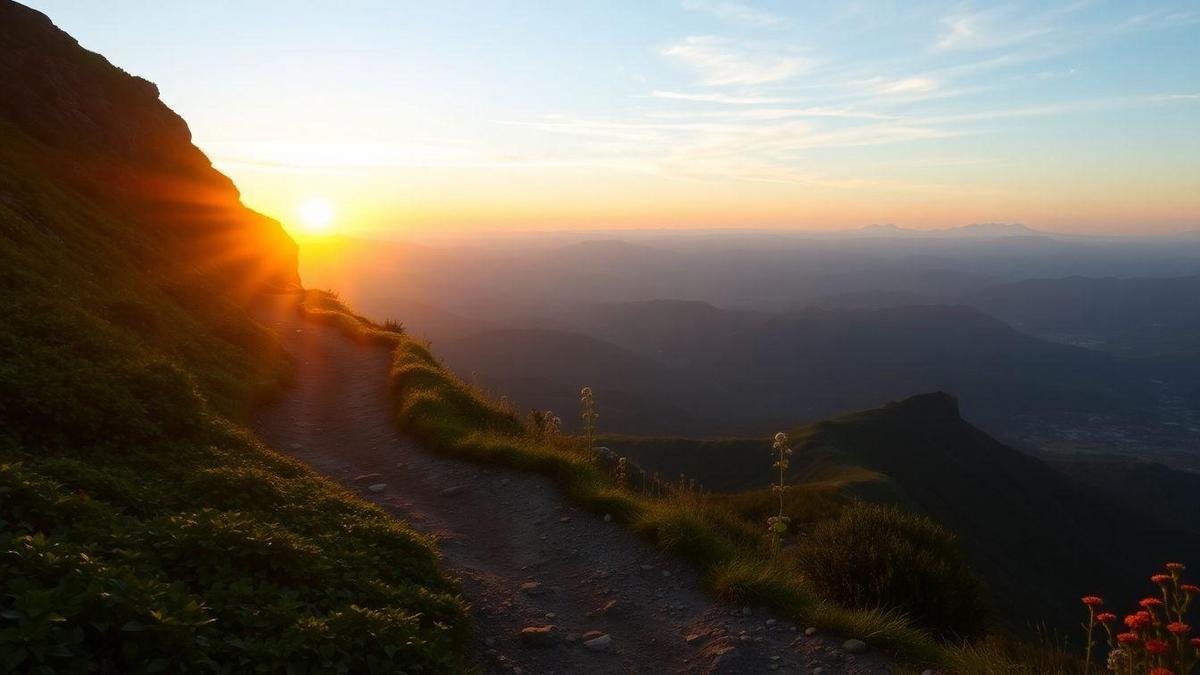
Choosing the Right Hiking Boots
Importance of Good Footwear
When you’re out exploring the beautiful mountains and rivers, having the right footwear is key. Good hiking boots can make or break your adventure. They protect your feet from rocks, mud, and uneven ground, helping you stay comfortable on long trails. Remember, your feet are your foundation; if they’re happy, you’ll enjoy your hike much more. For more insights on making the most of your outdoor adventures, consider checking out some best travel tips.
Features to Look for in Hiking Boots
When shopping for hiking boots, keep an eye out for these important features:
| Feature | Description |
|---|---|
| Support | Look for boots with good ankle support to prevent injuries on rough terrain. |
| Waterproof | Ensure your boots are waterproof, especially if you plan to cross rivers or hike in wet conditions. |
| Traction | A sturdy sole with good grip is essential for stability on slippery or rocky paths. |
| Breathability | Choose boots that allow air to flow, keeping your feet cool and dry. |
How to Ensure a Comfortable Fit
Finding the right fit is crucial for your hiking experience. Here are some tips to help you:
- Try Them On: Always try on boots with the socks you plan to wear for a better idea of how they’ll feel on the trail.
- Walk Around: Take a few steps in the store to ensure there’s enough room in the toe box without your foot sliding around.
- Check the Heel: Your heel shouldn’t lift when you walk; a snug fit helps prevent blisters.
- Break Them In: Walk around in your boots at home to break them in and avoid discomfort on the trail.
Essential Clothing for Mountain Hiking
Layering for Changing Weather
When you’re out in the mountains, weather can change in a heartbeat. Layering your clothing is key. Think of it like making a delicious sandwich: you start with a base, add some tasty fillings, and then top it off.
- Base Layer: This layer, close to your skin, keeps moisture away and helps you stay dry. Look for materials like merino wool or synthetic fabrics.
- Middle Layer: This layer provides warmth. Fleece or down jackets work well here, trapping heat while allowing moisture to escape.
- Outer Layer: Your shield against wind and rain. A good waterproof jacket is essential for staying dry and protected from the elements.
Choosing Durable Hiking Clothing
When you’re hiking, you want clothes that can handle the rough and tumble of the great outdoors. Look for clothing that is tough but comfortable.
- Pants: Choose pants made from durable materials like nylon or polyester that are flexible enough for movement.
- Footwear: Invest in sturdy hiking boots that provide good support and grip; a slip can lead to a nasty fall!
- Accessories: Don’t forget a good hat and sunglasses for sun protection and comfort.
Best Fabrics for Mountain Conditions
The fabric you choose can significantly impact your hiking experience. Here’s a quick look at some of the best options:
| Fabric Type | Benefits |
|---|---|
| Merino Wool | Keeps you warm, wicks moisture away |
| Synthetic | Quick-drying, lightweight |
| Fleece | Provides warmth without bulk |
| Nylon | Durable and resistant to tears |
Choosing the right fabric is like picking the right tools for a job; it makes your hike easier and more enjoyable. For more on essential gear for hiking in beautiful mountain areas, visit this resource.
Must-Have Hiking Gear for Safety
First Aid Kits and Emergency Supplies
When you’re out in the beautiful mountains and rivers, having a First Aid Kit is a must. Accidents can happen, and being prepared can make all the difference. Your kit should include:
- Adhesive bandages for cuts and scrapes
- Antiseptic wipes to keep wounds clean
- Pain relievers like ibuprofen or acetaminophen
- Gauze and tape for larger injuries
- A whistle to signal for help if needed
It’s wise to pack some extra supplies too, like a flashlight and batteries, to help you in case you find yourself in a tight spot. Remember, being ready for anything is part of the adventure!
Navigation Tools for Mountain Trails
Getting lost in the mountains can be scary, which is why navigation tools are vital. Here’s what you should have:
| Tool | Purpose |
|---|---|
| Map | Shows trails and landmarks |
| Compass | Helps you find your direction |
| GPS Device | Provides accurate location information |
Having these tools at your fingertips can make your hike smoother. You’ll feel more confident knowing you can find your way, even if the path gets tricky.
Staying Safe with the Right Gear
Wearing the right gear is just as important as having the right tools. Here are some essentials to keep you safe:
- Sturdy hiking boots provide support and grip.
- Weather-appropriate clothing keeps you warm or cool, depending on the season.
- A backpack helps you carry all your supplies comfortably.
When you’re well-equipped, you can focus on enjoying the stunning views and the fresh air. Hiking should be about the experience, not worrying about what you forgot!
Lightweight Accessories for Comfort
Hydration Packs and Water Bottles
Staying hydrated is key when you’re out in the beautiful mountains and by the rivers. Hydration packs are a great choice, allowing you to sip water easily while you hike without feeling heavy.
Water bottles are another option. Look for ones that are lightweight and easy to carry; some even have built-in filters, so you can fill them up from rivers and streams. This way, you can enjoy the fresh mountain air without worrying about running out of water.
Lightweight Hiking Accessories to Consider
When you’re hiking, every ounce counts. Here are some lightweight accessories to think about:
- Trekking Poles: These can help you keep your balance and save your knees on tough trails.
- Compact Backpack: Choose one that fits snugly and is easy to carry.
- Quick-Dry Towels: Handy for wiping sweat or drying off after a river dip.
- Portable Snacks: Pack lightweight snacks like nuts or energy bars for a quick boost.
The Benefits of Packing Light
Packing light is like a breath of fresh air—it makes your hike so much easier! When you carry less, you can move faster and enjoy the scenery more. You won’t feel weighed down and will have more energy to explore. Plus, if you need to cross a river or climb a steep hill, you’ll be glad you didn’t pack extra gear.
| Accessory | Weight (approx.) | Benefits |
|---|---|---|
| Hydration Pack | 1-2 lbs | Hands-free hydration |
| Trekking Poles | 1-2 lbs | Stability and support |
| Compact Backpack | 1-3 lbs | Easy to carry, fits essentials |
| Quick-Dry Towel | 0.5 lbs | Lightweight and absorbent |
| Portable Snacks | 0.5-1 lb | Energy boost without bulk |
Backpacking Gear for Mountains
Selecting the Right Backpack
Choosing the right backpack can feel like finding the perfect pair of shoes. You want it to fit just right, be comfy, and hold everything you need. A good backpack can make all the difference when you’re heading into the mountains.
Here are a few things to consider:
- Size: Think about how long your trip will be. A smaller pack (20-40 liters) is great for day hikes, while a larger pack (50-70 liters) is better for longer trips.
- Fit: Make sure it fits your body well. Try it on with some weight to see how it feels and ensure you can adjust the straps easily.
- Weight: Look for lightweight options; you don’t want to carry a heavy pack up a mountain!
Organizing Your Backpack Efficiently
Once you have your backpack, it’s time to pack it smartly. Organizing your gear can save you time and energy on the trail. Here are some tips:
- Heavy Items at the Bottom: Place your heavier gear at the bottom to keep your center of gravity low and help you balance.
- Use Pockets: Use the side pockets for water bottles and snacks, keeping frequently needed items like a map or first-aid kit in the top pocket.
- Roll Your Clothes: Rolling clothes takes up less space than folding and helps keep them wrinkle-free!
Essential Gear for Hiking in Beautiful Mountain Areas with River Access
When hiking in stunning mountain areas with rivers nearby, you’ll want to pack some essential gear. Here’s a handy table with what to bring:
| Gear Item | Purpose |
|---|---|
| Water Bottle | Stay hydrated during your hike |
| Lightweight Tent | Shelter for overnight stays |
| First-Aid Kit | Handle minor injuries |
| Food & Snacks | Keep your energy up |
| Map & Compass | Navigate the trails |
| Quick-Dry Towel | Dry off after a river dip |
| Sturdy Hiking Boots | Protect your feet and provide support |
| Sunscreen | Protect your skin from UV rays |
Having the right gear means you can focus on enjoying the breathtaking views and the sound of flowing rivers. Imagine sipping water from your bottle while gazing at the peaks around you. It’s moments like these that make all the packing worth it! For more ideas on the best camping locations, explore this guide.
Planning Your Hiking Route
Researching Trails with River Access
When you’re planning a hike, finding trails with river access can make your adventure even more special. Imagine the sound of water flowing as you trek through stunning landscapes. Start by checking local hiking websites or apps, which often list trails with nearby rivers.
Here are a few tips to help you find the right trail:
- Ask locals: They often know the best spots.
- Look for maps: Many parks have maps showing river trails.
- Join hiking groups: They can share hidden gems.
Understanding Trail Difficulty Levels
Not every trail is the same; some are easy strolls, while others might test your limits. It’s important to know the difficulty level before you head out. Here’s a simple guide:
| Difficulty Level | Description | Best For |
|---|---|---|
| Easy | Flat paths, short distances | Families, beginners |
| Moderate | Some hills, longer distances | Casual hikers, moderate fitness |
| Hard | Steep climbs, rugged terrain | Experienced hikers |
Choosing the right trail for your skill level can make your hike enjoyable and safe. For those looking for scenic views, explore the most incredible peaks.
Tips for a Successful Hiking Experience
To have a great time on your hike, keep these tips in mind:
- Pack wisely: Bring essential gear for hiking in beautiful mountain areas with river access, including water, snacks, and a first-aid kit.
- Stay hydrated: Drink water before, during, and after your hike.
- Dress in layers: Weather can change quickly, so be prepared.
- Know your limits: If a trail feels too tough, it’s okay to turn back.
By planning your route carefully and understanding what to expect, you can enjoy the beauty of nature without any hiccups.
Frequently Asked Questions
What is essential gear for hiking in beautiful mountain areas with river access?
You need sturdy shoes, a good backpack, water bottles, and a first-aid kit. Don’t forget snacks and a map too!
How do I choose the right hiking boots?
Look for boots that fit well and offer good grip. Try them on with thick socks to see how they feel; comfort is key!
What should I pack for a day hike?
Pack water, energy snacks, a map, sunscreen, and a lightweight jacket. Always bring essentials for safety!
Do I need a water filter for hiking near rivers?
Yes, a water filter is smart; it keeps your water safe from contaminants. Better to be safe than sorry!
How can I stay safe while hiking in the mountains?
Stick to marked trails, tell someone your plan, and keep an eye on the weather. Safety should always be your top priority!


